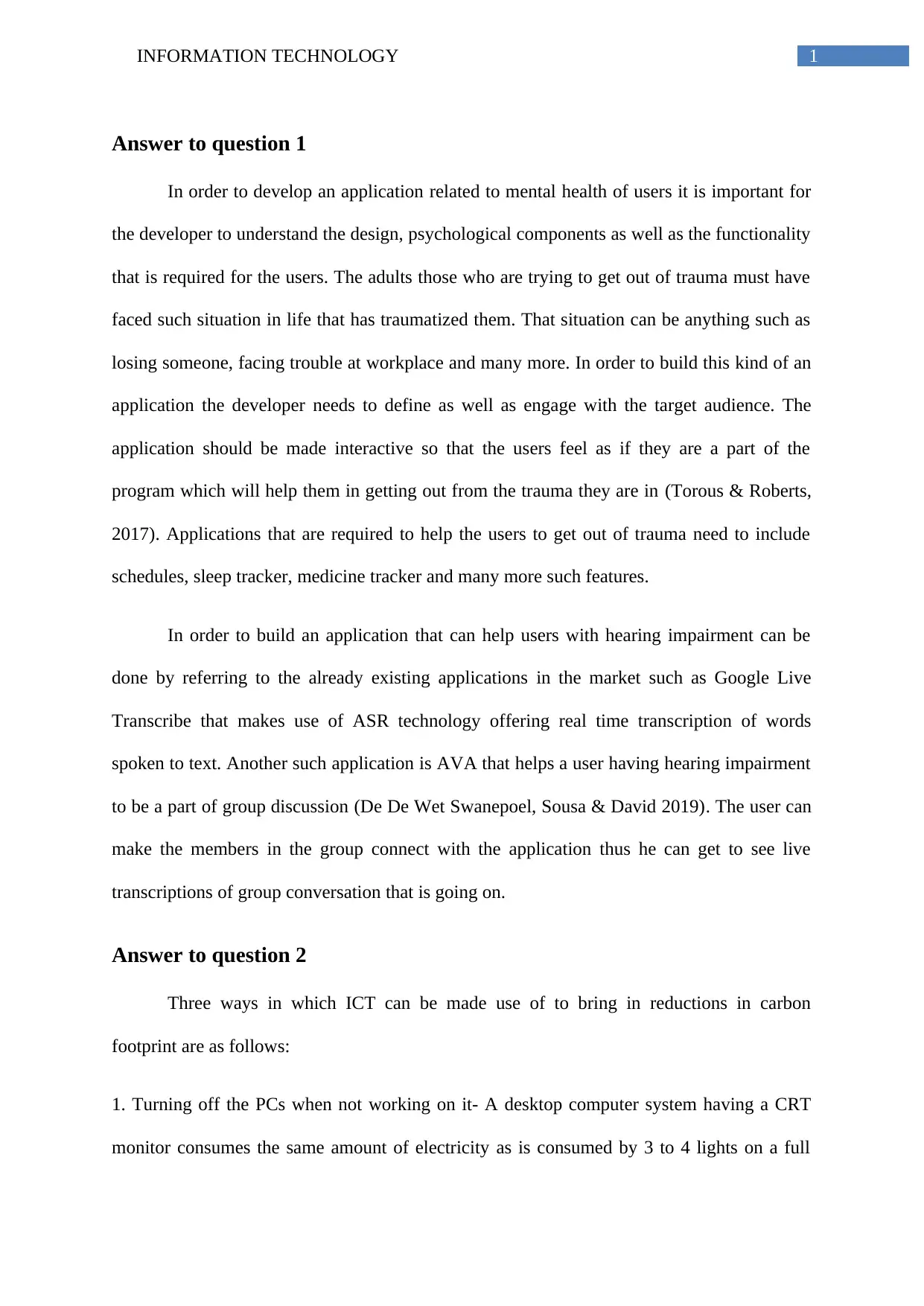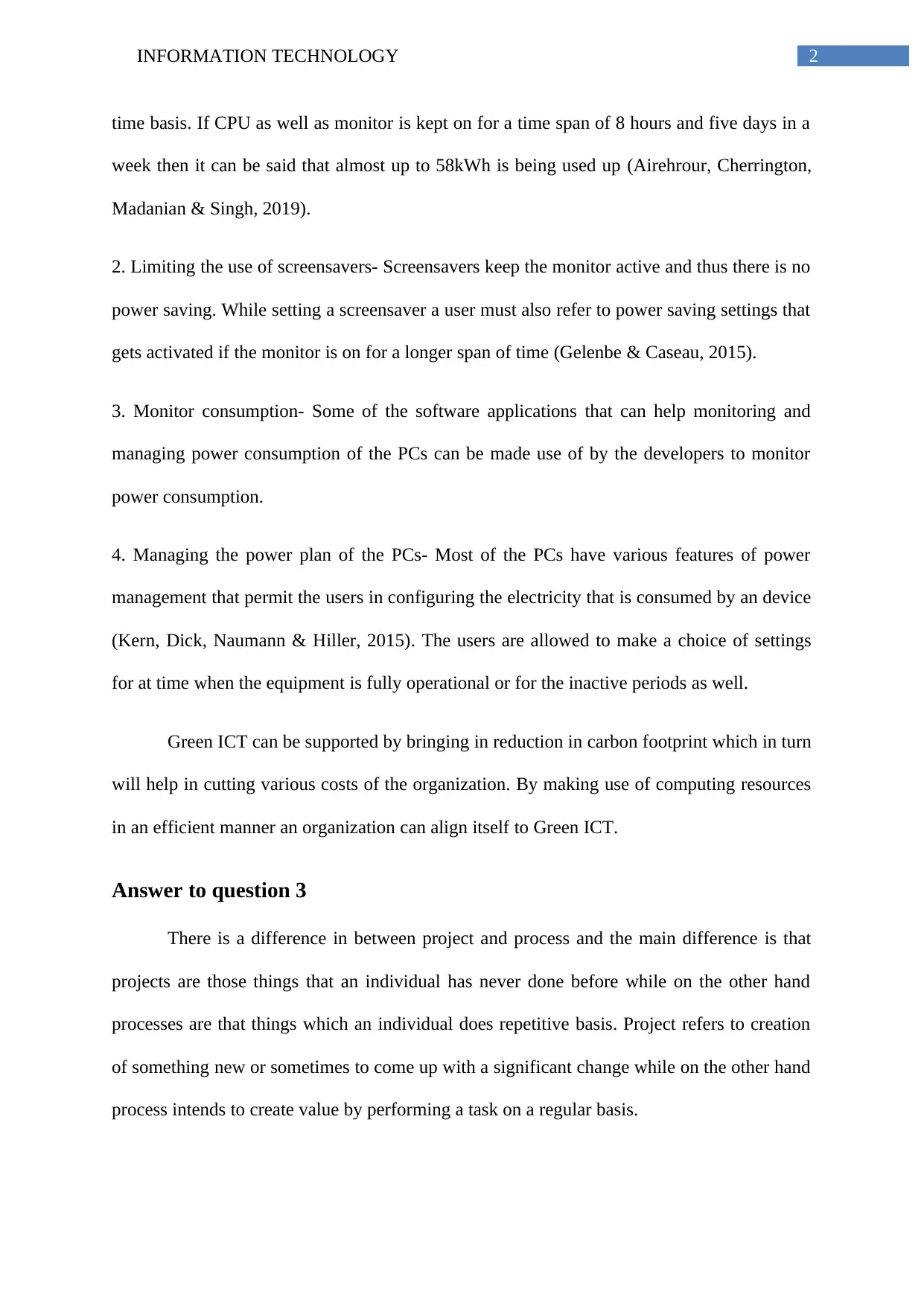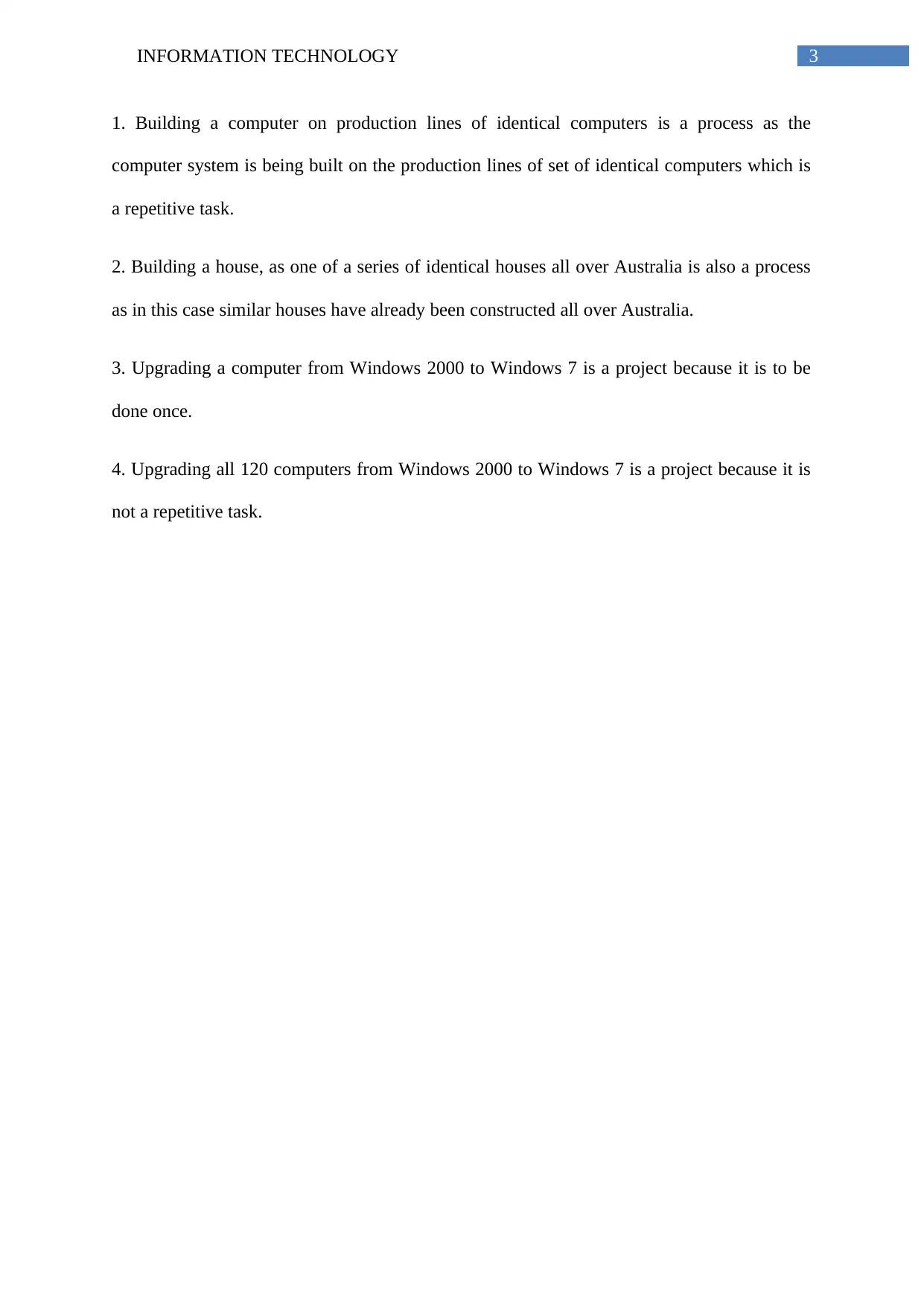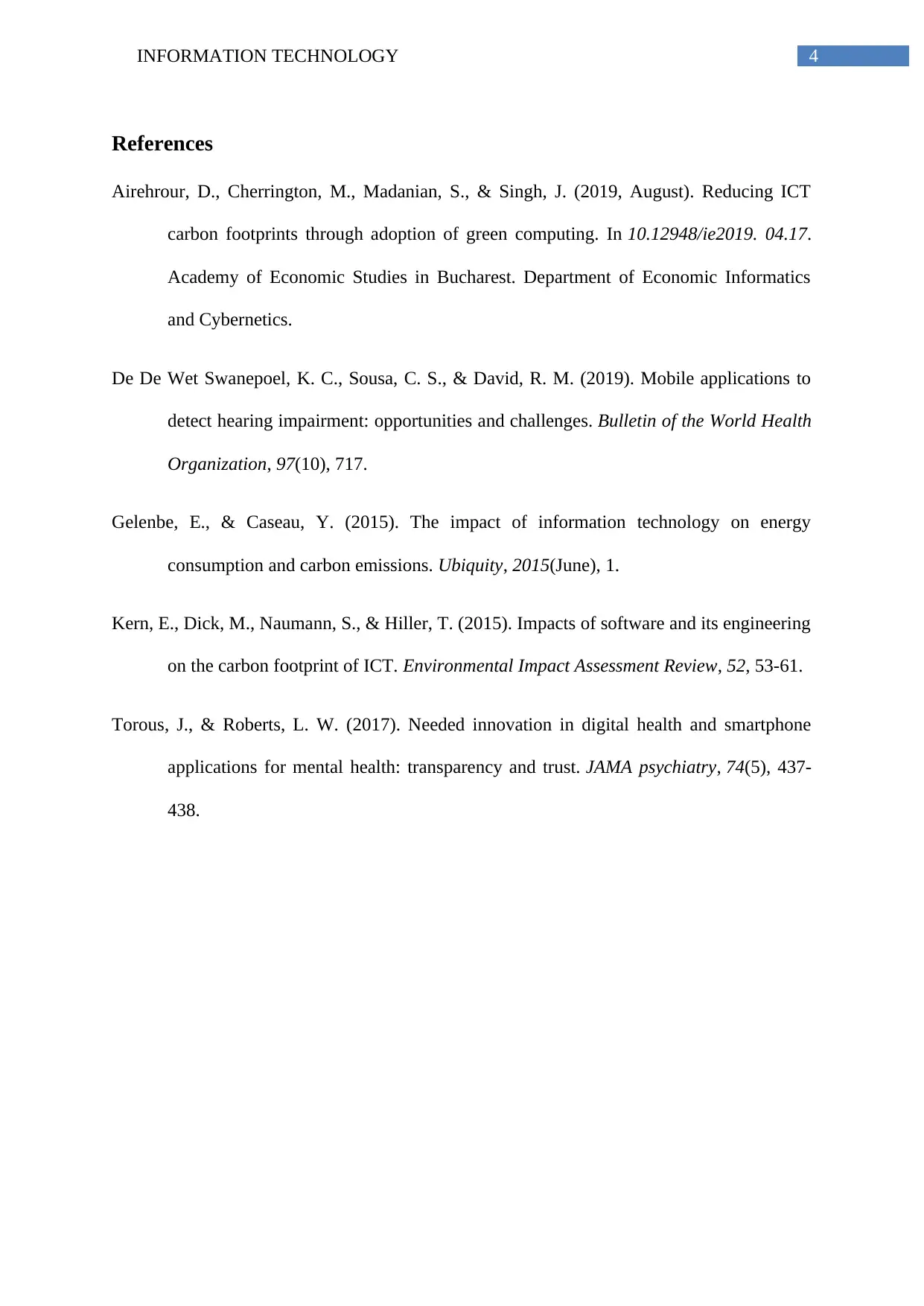Information Technology Assignment - Mental Health, ICT, Projects
VerifiedAdded on 2022/08/28
|5
|1030
|19
Homework Assignment
AI Summary
This IT assignment explores several key areas within information technology. The first section delves into the development of mental health applications, emphasizing the importance of understanding user psychology, trauma, and interactive design elements. It also discusses applications for users with hearing impairments, referencing examples like Google Live Transcribe and AVA. The second section focuses on reducing the carbon footprint through ICT, suggesting strategies such as turning off PCs, limiting screensaver use, and managing power consumption. Finally, the assignment differentiates between projects and processes, providing examples like building computers on a production line (process) versus upgrading a computer's operating system (project). The document includes relevant references to support the analysis.

Running head: INFORMATION TECHNOLOGY
INFORMATION TECHNOLOGY
Name of the Student
Name of the university
Author note
INFORMATION TECHNOLOGY
Name of the Student
Name of the university
Author note
Paraphrase This Document
Need a fresh take? Get an instant paraphrase of this document with our AI Paraphraser

1INFORMATION TECHNOLOGY
Answer to question 1
In order to develop an application related to mental health of users it is important for
the developer to understand the design, psychological components as well as the functionality
that is required for the users. The adults those who are trying to get out of trauma must have
faced such situation in life that has traumatized them. That situation can be anything such as
losing someone, facing trouble at workplace and many more. In order to build this kind of an
application the developer needs to define as well as engage with the target audience. The
application should be made interactive so that the users feel as if they are a part of the
program which will help them in getting out from the trauma they are in (Torous & Roberts,
2017). Applications that are required to help the users to get out of trauma need to include
schedules, sleep tracker, medicine tracker and many more such features.
In order to build an application that can help users with hearing impairment can be
done by referring to the already existing applications in the market such as Google Live
Transcribe that makes use of ASR technology offering real time transcription of words
spoken to text. Another such application is AVA that helps a user having hearing impairment
to be a part of group discussion (De De Wet Swanepoel, Sousa & David 2019). The user can
make the members in the group connect with the application thus he can get to see live
transcriptions of group conversation that is going on.
Answer to question 2
Three ways in which ICT can be made use of to bring in reductions in carbon
footprint are as follows:
1. Turning off the PCs when not working on it- A desktop computer system having a CRT
monitor consumes the same amount of electricity as is consumed by 3 to 4 lights on a full
Answer to question 1
In order to develop an application related to mental health of users it is important for
the developer to understand the design, psychological components as well as the functionality
that is required for the users. The adults those who are trying to get out of trauma must have
faced such situation in life that has traumatized them. That situation can be anything such as
losing someone, facing trouble at workplace and many more. In order to build this kind of an
application the developer needs to define as well as engage with the target audience. The
application should be made interactive so that the users feel as if they are a part of the
program which will help them in getting out from the trauma they are in (Torous & Roberts,
2017). Applications that are required to help the users to get out of trauma need to include
schedules, sleep tracker, medicine tracker and many more such features.
In order to build an application that can help users with hearing impairment can be
done by referring to the already existing applications in the market such as Google Live
Transcribe that makes use of ASR technology offering real time transcription of words
spoken to text. Another such application is AVA that helps a user having hearing impairment
to be a part of group discussion (De De Wet Swanepoel, Sousa & David 2019). The user can
make the members in the group connect with the application thus he can get to see live
transcriptions of group conversation that is going on.
Answer to question 2
Three ways in which ICT can be made use of to bring in reductions in carbon
footprint are as follows:
1. Turning off the PCs when not working on it- A desktop computer system having a CRT
monitor consumes the same amount of electricity as is consumed by 3 to 4 lights on a full

2INFORMATION TECHNOLOGY
time basis. If CPU as well as monitor is kept on for a time span of 8 hours and five days in a
week then it can be said that almost up to 58kWh is being used up (Airehrour, Cherrington,
Madanian & Singh, 2019).
2. Limiting the use of screensavers- Screensavers keep the monitor active and thus there is no
power saving. While setting a screensaver a user must also refer to power saving settings that
gets activated if the monitor is on for a longer span of time (Gelenbe & Caseau, 2015).
3. Monitor consumption- Some of the software applications that can help monitoring and
managing power consumption of the PCs can be made use of by the developers to monitor
power consumption.
4. Managing the power plan of the PCs- Most of the PCs have various features of power
management that permit the users in configuring the electricity that is consumed by an device
(Kern, Dick, Naumann & Hiller, 2015). The users are allowed to make a choice of settings
for at time when the equipment is fully operational or for the inactive periods as well.
Green ICT can be supported by bringing in reduction in carbon footprint which in turn
will help in cutting various costs of the organization. By making use of computing resources
in an efficient manner an organization can align itself to Green ICT.
Answer to question 3
There is a difference in between project and process and the main difference is that
projects are those things that an individual has never done before while on the other hand
processes are that things which an individual does repetitive basis. Project refers to creation
of something new or sometimes to come up with a significant change while on the other hand
process intends to create value by performing a task on a regular basis.
time basis. If CPU as well as monitor is kept on for a time span of 8 hours and five days in a
week then it can be said that almost up to 58kWh is being used up (Airehrour, Cherrington,
Madanian & Singh, 2019).
2. Limiting the use of screensavers- Screensavers keep the monitor active and thus there is no
power saving. While setting a screensaver a user must also refer to power saving settings that
gets activated if the monitor is on for a longer span of time (Gelenbe & Caseau, 2015).
3. Monitor consumption- Some of the software applications that can help monitoring and
managing power consumption of the PCs can be made use of by the developers to monitor
power consumption.
4. Managing the power plan of the PCs- Most of the PCs have various features of power
management that permit the users in configuring the electricity that is consumed by an device
(Kern, Dick, Naumann & Hiller, 2015). The users are allowed to make a choice of settings
for at time when the equipment is fully operational or for the inactive periods as well.
Green ICT can be supported by bringing in reduction in carbon footprint which in turn
will help in cutting various costs of the organization. By making use of computing resources
in an efficient manner an organization can align itself to Green ICT.
Answer to question 3
There is a difference in between project and process and the main difference is that
projects are those things that an individual has never done before while on the other hand
processes are that things which an individual does repetitive basis. Project refers to creation
of something new or sometimes to come up with a significant change while on the other hand
process intends to create value by performing a task on a regular basis.
⊘ This is a preview!⊘
Do you want full access?
Subscribe today to unlock all pages.

Trusted by 1+ million students worldwide

3INFORMATION TECHNOLOGY
1. Building a computer on production lines of identical computers is a process as the
computer system is being built on the production lines of set of identical computers which is
a repetitive task.
2. Building a house, as one of a series of identical houses all over Australia is also a process
as in this case similar houses have already been constructed all over Australia.
3. Upgrading a computer from Windows 2000 to Windows 7 is a project because it is to be
done once.
4. Upgrading all 120 computers from Windows 2000 to Windows 7 is a project because it is
not a repetitive task.
1. Building a computer on production lines of identical computers is a process as the
computer system is being built on the production lines of set of identical computers which is
a repetitive task.
2. Building a house, as one of a series of identical houses all over Australia is also a process
as in this case similar houses have already been constructed all over Australia.
3. Upgrading a computer from Windows 2000 to Windows 7 is a project because it is to be
done once.
4. Upgrading all 120 computers from Windows 2000 to Windows 7 is a project because it is
not a repetitive task.
Paraphrase This Document
Need a fresh take? Get an instant paraphrase of this document with our AI Paraphraser

4INFORMATION TECHNOLOGY
References
Airehrour, D., Cherrington, M., Madanian, S., & Singh, J. (2019, August). Reducing ICT
carbon footprints through adoption of green computing. In 10.12948/ie2019. 04.17.
Academy of Economic Studies in Bucharest. Department of Economic Informatics
and Cybernetics.
De De Wet Swanepoel, K. C., Sousa, C. S., & David, R. M. (2019). Mobile applications to
detect hearing impairment: opportunities and challenges. Bulletin of the World Health
Organization, 97(10), 717.
Gelenbe, E., & Caseau, Y. (2015). The impact of information technology on energy
consumption and carbon emissions. Ubiquity, 2015(June), 1.
Kern, E., Dick, M., Naumann, S., & Hiller, T. (2015). Impacts of software and its engineering
on the carbon footprint of ICT. Environmental Impact Assessment Review, 52, 53-61.
Torous, J., & Roberts, L. W. (2017). Needed innovation in digital health and smartphone
applications for mental health: transparency and trust. JAMA psychiatry, 74(5), 437-
438.
References
Airehrour, D., Cherrington, M., Madanian, S., & Singh, J. (2019, August). Reducing ICT
carbon footprints through adoption of green computing. In 10.12948/ie2019. 04.17.
Academy of Economic Studies in Bucharest. Department of Economic Informatics
and Cybernetics.
De De Wet Swanepoel, K. C., Sousa, C. S., & David, R. M. (2019). Mobile applications to
detect hearing impairment: opportunities and challenges. Bulletin of the World Health
Organization, 97(10), 717.
Gelenbe, E., & Caseau, Y. (2015). The impact of information technology on energy
consumption and carbon emissions. Ubiquity, 2015(June), 1.
Kern, E., Dick, M., Naumann, S., & Hiller, T. (2015). Impacts of software and its engineering
on the carbon footprint of ICT. Environmental Impact Assessment Review, 52, 53-61.
Torous, J., & Roberts, L. W. (2017). Needed innovation in digital health and smartphone
applications for mental health: transparency and trust. JAMA psychiatry, 74(5), 437-
438.
1 out of 5
Related Documents
Your All-in-One AI-Powered Toolkit for Academic Success.
+13062052269
info@desklib.com
Available 24*7 on WhatsApp / Email
![[object Object]](/_next/static/media/star-bottom.7253800d.svg)
Unlock your academic potential
Copyright © 2020–2025 A2Z Services. All Rights Reserved. Developed and managed by ZUCOL.





